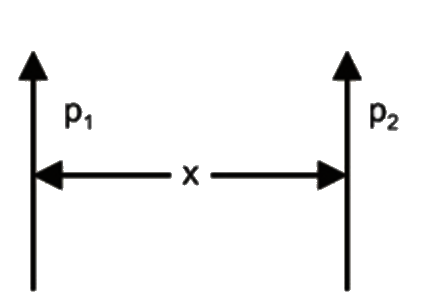Two magnetic poles, one of the which is four times stronger than the other, exert a force of 10gf on each other when placed at a distance of 20cm. Find the strength of each pole.
To solve the problem step by step, we will follow the concepts of magnetic pole strength and the force between them.
Step 1: Understand the Problem
We have two magnetic poles, where one pole (P1) is four times stronger than the other pole (P2). The force between them is given as 10 gf when they are separated by a distance of 20 cm.
Step 2: Convert Units
Convert the force from gram-force to Newtons:
- 1 gf = 0.00981 N (approximately 0.01 N for simplicity)
- Therefore, 10 gf = 10 * 0.00981 N = 0.0981 N (approximately 0.1 N).
Step 3: Use the Formula for Force Between Magnetic Poles
The formula for the force (F) between two magnetic poles is given by:
F=μ04π⋅P1⋅P2R2
Where:
- F = force between the poles
- P1 = strength of the first pole
- P2 = strength of the second pole
- R = distance between the poles
- μ0 = permeability of free space = 4π×10−7T m/A
Step 4: Substitute Known Values
Given:
- F=0.1N
- R=20cm=0.2m
- P1=4P2
Substituting these values into the formula:
0.1=(4π×10−7)4π⋅(4P2)⋅P2(0.2)2
Step 5: Simplify the Equation
This simplifies to:
0.1=10−7⋅4P220.04
0.1=10−7⋅100P22
0.1=10−5P22
Step 6: Solve for P2
Rearranging gives:
P22=0.110−5
P22=106
P2=100A m
Step 7: Find P1
Since P1=4P2:
P1=4⋅100=400A m
Final Answer
The strengths of the magnetic poles are:
- P1=400A m
- P2=100A m
We have two magnetic poles, where one pole (P1) is four times stronger than the other pole (P2). The force between them is given as 10 gf when they are separated by a distance of 20 cm.
Convert the force from gram-force to Newtons:
- 1 gf = 0.00981 N (approximately 0.01 N for simplicity)
- Therefore, 10 gf = 10 * 0.00981 N = 0.0981 N (approximately 0.1 N).
The formula for the force (F) between two magnetic poles is given by:
F=μ04π⋅P1⋅P2R2
Where:
- F = force between the poles
- P1 = strength of the first pole
- P2 = strength of the second pole
- R = distance between the poles
- μ0 = permeability of free space = 4π×10−7T m/A
Given:
- F=0.1N
- R=20cm=0.2m
- P1=4P2
0.1=(4π×10−7)4π⋅(4P2)⋅P2(0.2)2
This simplifies to:
0.1=10−7⋅4P220.04
0.1=10−7⋅100P22
0.1=10−5P22
Rearranging gives:
P22=0.110−5
P22=106
P2=100A m
Since P1=4P2:
P1=4⋅100=400A m
The strengths of the magnetic poles are:
- P1=400A m
- P2=100A m
Topper's Solved these Questions
- MAGNETISM AND MATTERBook:DC PANDEY ENGLISHChapter:MAGNETISM AND MATTERExercise:5.1
Explore 15 Videos
- MAGNETISM AND MATTERBook:DC PANDEY ENGLISHChapter:MAGNETISM AND MATTERExercise:5.2
Explore 15 Videos
- MAGNETICSBook:DC PANDEY ENGLISHChapter:MAGNETICSExercise:MCQ_TYPE
Explore 1 Video
- MODERN PHYSICSBook:DC PANDEY ENGLISHChapter:MODERN PHYSICSExercise:Integer Type Questions
Explore 17 Videos
Similar Questions
Which of the following pairs particles cannot exert nuclear force on each other ?
View SolutionFind the force of interaction of two dipoles , if the two dipole moments are parallel to each other and placed at a distance x apart

View SolutionTwo charges of equal magnitudes and at a distance r exert a force F on each other. If the charges are halved and distance between them is doubled, then the new force acting on each charge is
View SolutionIf a magnet of pole strenth m is divided into four parts such that the length and width of each part is half that of initial one, then the pole strength of each part will be
View SolutionTwo protons are a distance of 1×10−10cm from each other. The force acting on them are
View SolutionTwo charges spheres are separated at a distance d exert a force F on each other, if charges are doubled and distance between them is doubled then the force is
View SolutionCan you think of two particles which do not exert gravitational force on each other?
View SolutionTwo short bar magnets of length 1cm each have magnetic moments 1.20Am2and1.00Am2 respectively. They are placed on a horizontal table parallel to each other with their N poles pointing towards the south. They have a common magnetic equator and are separted by a distance of 20.0cm. The value of the resultant horizontal magnetic induction at the mid - point O of the line joining their centres is close to (Horizontal component of earths magnetic induction is 3.6×10.5Wh/m2
View SolutionTwo identical thin bar magnets, each of length L and pole strength m are placed at right angles to each other, with the N pole of one touching the S-pole of the other. Find the magnetic moment of the system.
View SolutionA bar magnet 30cm long is placed in magnetic meridian with its north pole pointing south. The neutral point is observed at a distance of 30cm from its centre. Calculate the pole strength of the magnet. Given horizontal component of earth's field is 0⋅34G.
View Solution